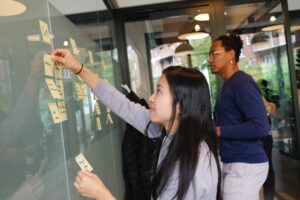Quick, think of your favorite SaaS company. Now go to their website and click on “Resources.” If the company is large enough, they almost certainly have an associated “Academy” or “University”. For example…
Large SaaS companies spend a significant portion of their budget on these online “academies”. This article, for example, highlights the incredible growth of the Hubspot Academy. Initially launched in 2012, by 2016 Hubspot Academy was supported by a full-time team of more than a dozen and awarded over 8,000 certifications a year.
But what exactly is a SaaS University?
SaaS universities aren’t selling software. They aren’t selling technology. They are selling capabilities. Let’s take one of our favorite SaaS companies: Measured. The Measured Intelligence Suite of software is powerful, robust technology. But if you go to the Measured website, the first thing the company describes is not its technology. Instead, they focus on the following three capabilities…
- Increase media efficiency
- Manage your marketing data
- Grow your business
Technology is critical. But technology alone doesn’t change behavior. Technology + Learning does. And the learning comes from the SaaS University.
Before the SaaS University, most Resources pages included a host of content, including blogs, webinars, white papers, customer testimonials, and more. Resources pages were like libraries. You could find what you needed, but the customer had to know the answer to two crucial questions: a) where should I start, and b) why should I keep going?
If you’re a SaaS company wondering why your Resources page doesn’t see more visitors, it is because learners can’t answer those two questions.
By comparison, each course within the SaaS University has a clear starting point, quizzes to test your knowledge, and a way to track your progress. When you finish a course, you know exactly what you’ve learned and you often get a certificate you can post on LinkedIn.
How do you create a community around your SaaS university?

Learning Structure
Your content must be achievement-oriented. Completing a course should be an active, not passive activity, requiring the completion of an assessment. Completion of a learning path should be something you can make public through a certificate you can post on LinkedIn.
Individual achievements at all levels of learning should be celebrated. Leaderboards and progress bars are ways that learners can share their progress, their badges, and cheer each other on along the way. Extrinsic motivation can heighten the odds of learner completion in success which is the ultimate goal of any SaaS university.
Identifying levels of achievement that both motivate learners to continue and identify what skills they’ve gained so far is an excellent way to build community amongst your learners. Badges such as mentor or coach signify a learner’s understanding but also the ability to share that knowledge with others.
Offer content that challenges learners of all abilities (novices and experts, customers and non-customers). Offer tiered content and the proper breadth to ensure you have something for everyone.
You will lose learners unless they can quickly and easily answer these two questions: where should I start and why should I keep going? Build simple learning paths that help learners understand where to go next.
By allowing learners to not only preview their learning pathway, but see how the path has been traveled by other learners, you give users a sense of belonging and the ability to seek advice from those who’ve forged ahead and give advice to those following in their footsteps.
Your academy is not a place to promote your products. You can reference them and use them as examples, but your academy loses some of its power when learners feel like they are being sold.
Academy Structure
Nothing is anonymous in an academy. Some or all of a learner’s profile should be public; for many academies it is the most important element. Learners who join (everyone needs a log-in) should take pride in being themselves.
Remove the opportunity for back-of-classroom students who aren’t fully invested in learning by making certain elements of the community non-negotiable. Users are familiar with creating a bio when they register for platforms and adding that identity to your users gives them the ability to connect in a more tangible way.
Build user groups and help learners align with similar people in similar circumstances. There are too many different use cases and reasons to join your academy. Make it easy for learners to find others like them. By structuring these connections, theoretical application within an individual’s industry or position becomes concrete and therefore, more likely to be applied.
Establish a separate place for product knowledge and questions. Don’t allow “what is the future of remote work” and “how accurate is the GPS” to sit within the same forum. Provide your users with a clear place to ask their product questions.
Don’t expect learners to reach out on their own. Create a space with zero friction for connection between learners who can benefit from each other’s experience. Motivated learners can completely evolve a learning experience by building relationships with those who have similar experiences and pain points as their own.

Promotion
What’s in it for the experts? This is the key question. The goal is to avoid “graduation” while still honoring achievement. Recognize super users in a way that is motivating to the individual and aspirational to other learners. The identification of Expert, Innovator, Coach, or Trailblazer paired with benefits like early access to new courses is a strategy that aids both your SaaS University and your top learners.
Students who have completed your learning are valuable resources, they may serve as a first line of defense in their organization which minimizes your time spent on support. Additionally, their knowledge, hard-earned, in your services makes them less likely to shop around for competitors or reorg in a way that makes your product obsolete.
SaaS universities are not just about lead generation they are also about reducing churn. You are not only building a community amongst your broad learners, but maintaining or even strengthening the community within the organizations you serve.
As you try to build awareness and momentum around your academy, start with the people who already positively associate with your brand. Your first user group should be one that adds value both in follow-through and in feedback. Optimize success for your initial learners, and empower them to be champions for your SaaS University within their industry.
Celebrate community members not only for their learning progress, but for the successes achieved by implementing your product within their organization. Both growth and profit are newsworthy events that can be shared purposefully within the learning community and act as an exciting and motivating use case for members of your SaaS University.
Get in touch
If your SaaS company is ready to boost your engagement, build your thought leadership, and create an engaged learning community of brand ambassadors, we can help. Contact us today to learn more about how we help our clients build and scale SaaS universities for their markets.



